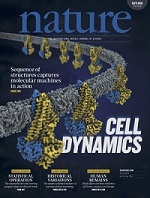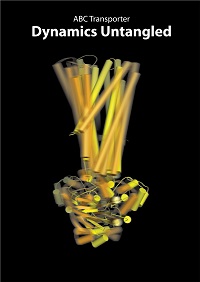News Archive
Translocation cycle of asymmetric ABC exporters resolved
 July 2019. ABC transporters are a ubiquitous family of important membrane proteins that shuttle a multitude of chemically diverse substrates across cell membranes. In humans, ABC transporters are responsible for many physiological processes, adaptive immunity and multidrug resistance as well as severe diseases such as cystic fibrosis, hypercholesterolemia, lipid-trafficking disorders and immunodeficiency. Frankfurt scientists now suceeded in resolving the fundamental steps of the substrate translocation cycle of asymmetric ABC transporters.
July 2019. ABC transporters are a ubiquitous family of important membrane proteins that shuttle a multitude of chemically diverse substrates across cell membranes. In humans, ABC transporters are responsible for many physiological processes, adaptive immunity and multidrug resistance as well as severe diseases such as cystic fibrosis, hypercholesterolemia, lipid-trafficking disorders and immunodeficiency. Frankfurt scientists now suceeded in resolving the fundamental steps of the substrate translocation cycle of asymmetric ABC transporters.
ABC exporters are highly dynamic molecular machines and extrude a wide range of substances from the inside of the cell. Despite their importance, many aspects of how ABC exporters function in detail, such as the coupling of nucleotide binding and their conformational dynamics, remains poorly resolved, especially for heterodimeric and thus asymmetric ABC exporters that are abundant in humans.
A team of Frankfurt scientists now present eight high-resolution cryo-EM structures that delineate the full functional cycle of an asymmetric ABC exporter in a lipid environment. The team used the heterodimeric ABC exporter TmrAB as a model system of the human TAP transporter. Like in all ABC transporters, two highly conserved nucleotide-binding domains mechan ochemically couple ATP binding and hydrolysis to two transmembrane domains that provide a framework for substrate uptake and release on opposite sides of the membrane. Substrate transport necessitates major conformational changes between inward-facing (IF) and outwardfacing open (OFopen) states.
ochemically couple ATP binding and hydrolysis to two transmembrane domains that provide a framework for substrate uptake and release on opposite sides of the membrane. Substrate transport necessitates major conformational changes between inward-facing (IF) and outwardfacing open (OFopen) states.
Their cryo-EM analysis under active turnover conditions revealed distinct inward-facing conformations — one of them with a bound peptide substrate — and previously undescribed asymmetric post-hydrolysis states with dimerized nucleotide-binding domains and a closed extracellular gate. By decreasing the rate of ATP hydrolysis, the scientists were able to capture an outwardfacing open conformation - an otherwise transient state vulnerable to substrate re-entry.
Their findings reveal that phosphate release, not ATP hydrolysis, triggers the return of the exporter to the IF conformation. By mapping the conformational landscape during active turnover, aided by mutational and chemical modulation of kinetic rates to trap the key intermediates, the team resolved fundamental steps of the substrate translocation cycle of asymmetric ABC transporters. More...
Contacts:
Robert Tampé, Institute of Biochemistry, Goethe University Frankfurt, tampe@em.uni-frankfurt.de
Arne Möller, Max Planck Institute of Biophysics, arne.moeller@biophys.mpg.de
Frankfurt am Main, Germany
Publication:
Susanne Hofmann#, Dovile Januliene#, Ahmad R. Mehdipour#, Christoph Thomas, Erich Stefan, Stefan Brüchert, Benedikt T. Kuhn, Eric R. Geertsma, Gerhard Hummer, Robert Tampé* & Arne Moeller* (2019) Conformation space of a heterodimeric ABC exporter under turnover conditions. Nature, published online 17 July 2019, https://doi.org/10.1038/s41586-019-1391-0 (link)

